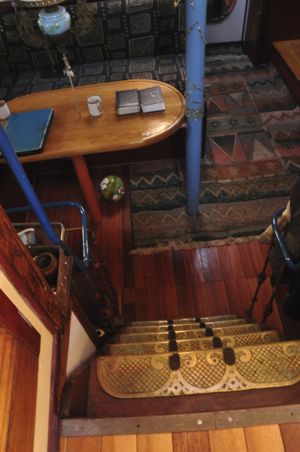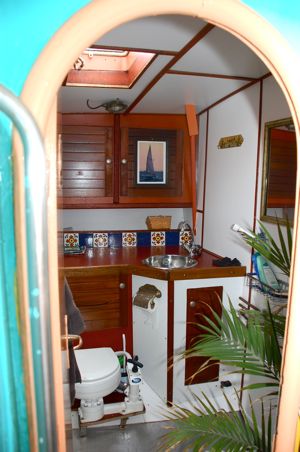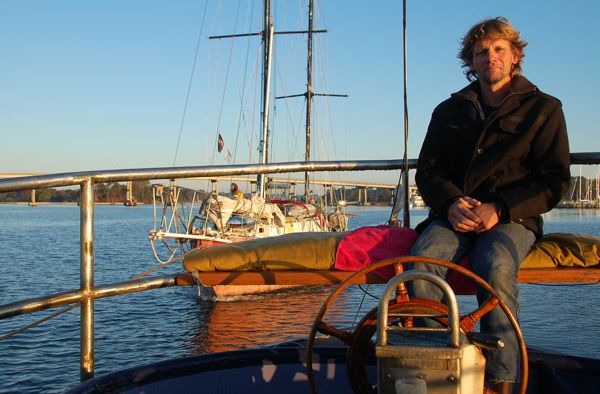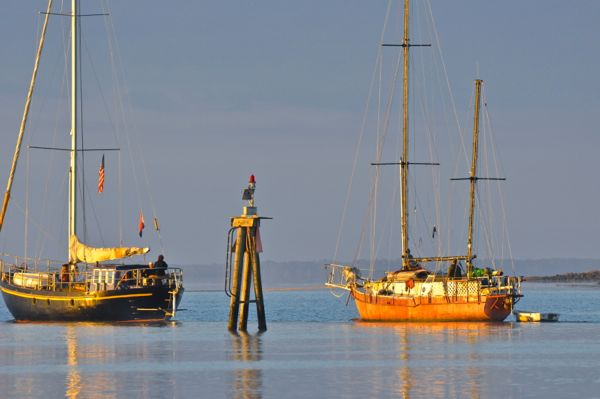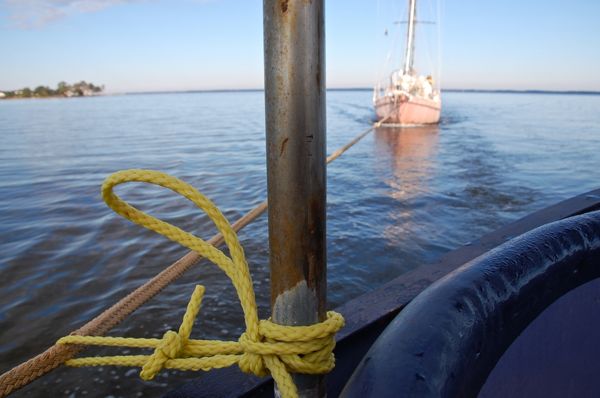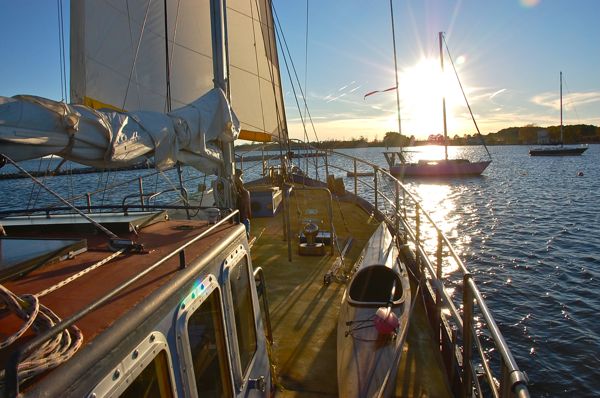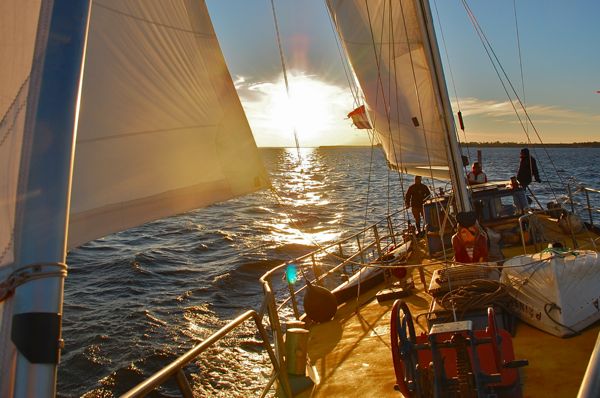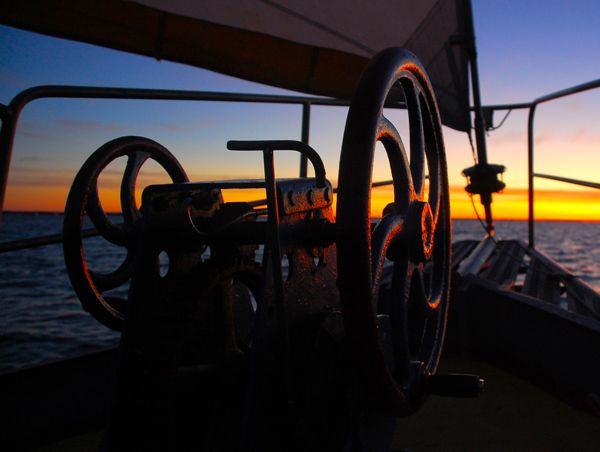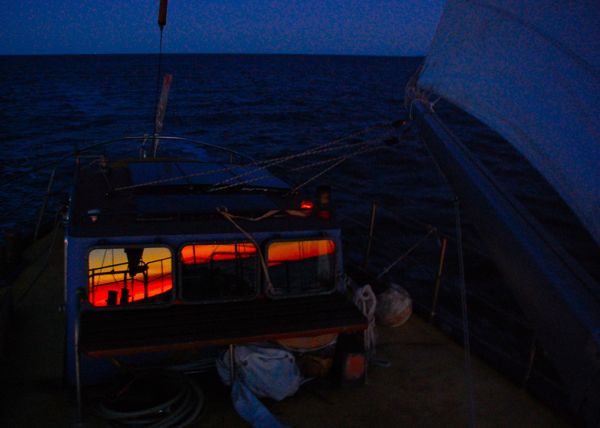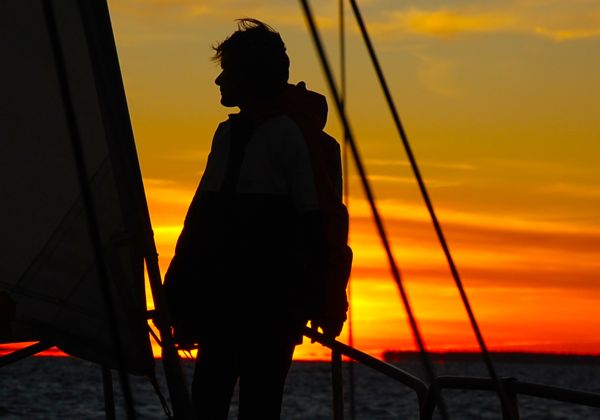It's Wednesday January 7, 2026

Lots of boats come to Oriental, some tie up at the Town Dock for a night or two, others drop anchor in the harbor for a while. If you've spent any time on the water you know that every boat has a story. The Shipping News on TownDock.net brings you the stories of the boats that have visited recently.
November 26, 2013
“It’s not normal.”Martijn Dijkstra says of his new home, the 25-ton steel sailboat, Prinses Mia. She is, he says, “a monster of a boat” – 50 feet long. That is a lot of space after living aboard a 30 foot long boat for years, as Martijn did on his previous steel boat Rotop.And the “It’s not normal” line also applies to Martijn’s approach to outfitting this vessel.
“Everyone says bigger boats are expensive,” Martijn says. “I want to prove they’re not.”
It helps that Martin is handy. His engine runs on used frying grease. His anchor is homemade. His windlass includes parts from a ship wreck, a muffler and an abandoned Maine sawmill.
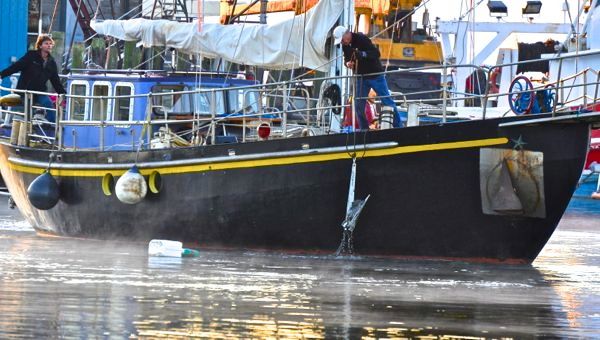 Prinses Mia the morning of November 12 as she prepares to tow Primadonna out of the Oriental anchorage. The red vessel had occupied the Oriental for a year and was a source of controversy. The towing is what made many in town grateful to Prinses Mia’s captain, Martijn Dykstra.
Prinses Mia the morning of November 12 as she prepares to tow Primadonna out of the Oriental anchorage. The red vessel had occupied the Oriental for a year and was a source of controversy. The towing is what made many in town grateful to Prinses Mia’s captain, Martijn Dykstra.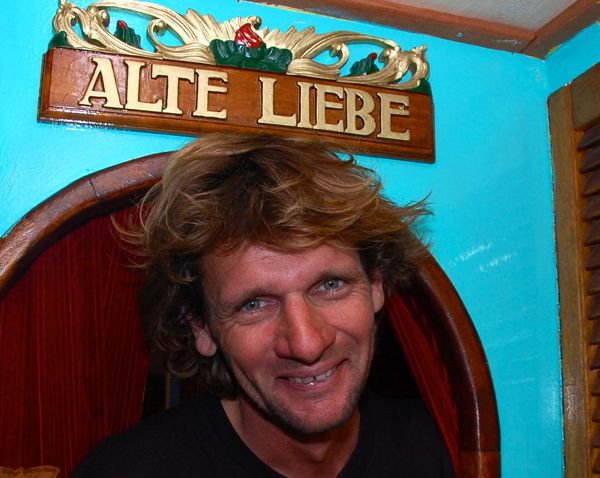 Martijn beneath the sign that leads to Princes Mia’s forward cabin. “Alte Liebe” means “old love”. He says his dad found the sign at a flea market. Martijn says it reminds him of the boat’s past owners who poured much time and love in to her but never got to sail her much.
Martijn beneath the sign that leads to Princes Mia’s forward cabin. “Alte Liebe” means “old love”. He says his dad found the sign at a flea market. Martijn says it reminds him of the boat’s past owners who poured much time and love in to her but never got to sail her much.While Martijn had visited Oriental many times in the past half decade on Rotop, this November was the first time Prinses Mia came to town. Here is the story of Prinses Mia.
Princess Mia is massive, black and steel. Built to a German design for the rigors of the North Sea, she is 17 feet wide and measures over 50 feet from the tip of her bowsprit to the end of her wind vane. Her mast is so tall, Martijn says, “the VHF antenna hits when we go under a bridge.” Fellow sailors kidded Martijn she’d have a hard time navigating the ICW. She draws 7 feet. At 25 tons, she needs to be handled carefully, especially when docking. “She will pop most fenders,” Martijn says.
She could just as easily burst a sailor’s budget.
Conventional wisdom says big boats cost big money. The cost of equipment increases as displacement goes up. The ratio is not linear. While a new anchor for a 20 foot sailboat might cost under 100 dollars, for a 30 footer, it could run to the hundreds. For a 45 foot boat – especially one as heavy as Princess Mia – it could run in to the thousands.
Not so for Prinses Mia.
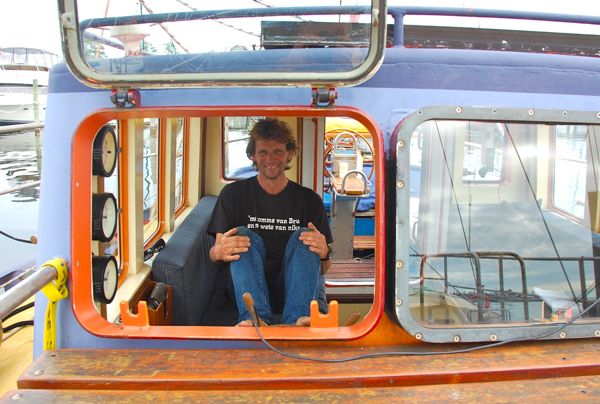 The pilot house house features an inside helm and engine controls. The three ports running down either side came from a salvage yard in Exeter, England.
The pilot house house features an inside helm and engine controls. The three ports running down either side came from a salvage yard in Exeter, England.After two decades of living aboard boats, Martijn had well-developed and resourceful ways for outfitting Prinses Mia. On deck, this approach has contributed greatly to Princes Mia’s look – both sturdily functional and colorful at the same time.
For instance, hanging from Prinses Mia’s starboard bow is a massive, slightly rusty anchor. While it resembles a $1,500 dollar version that might grace the anchor roller of a similarly-sized boat, Martijn acquired it for considerably less.
Like much of his cruising gear, he fabricated it himself.
“I built my anchor out of scrap steel,” Martijn says. Using an anchor he liked as his model, he cut pieces out of scrap steel plate and welded them together. Total price: $30. “If I had known how well it was going to work,” he says, “I would have built another one.”
Hauling up an anchor this size takes some effort and a windlass that, if bought new, would run into thousands of dollars. Martijn built his windlass for pennies on the dollar.
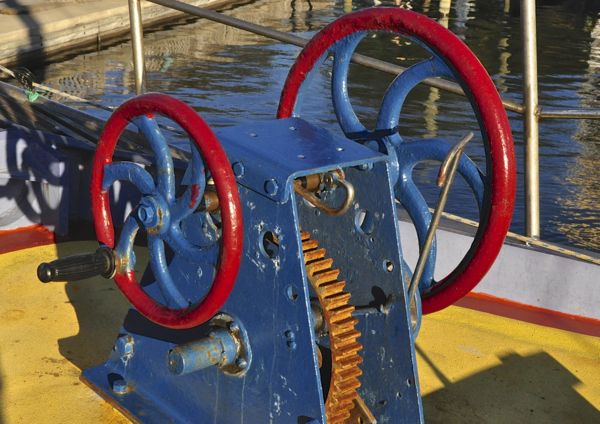 Princes Mia’s windlass. It is hand cranked.
Princes Mia’s windlass. It is hand cranked.When he got Prinses Mia, she had an electric windlass. Citing it as too complicated and expensive to operate – he says parts cost a fortune – he replaced it with a purely mechanical one. This one came from a scrapyard. It was little more than two large gears and two flywheels.
Martijn carries a generator and welding equipment aboard. Since he first installed his windlass, he replaced the original flywheels with a set he scavenged off a Portuguese wreck. The windlass is turned by hand. The wheels are so heavy, once they spin fast enough, the flywheel effect takes kicks in and Martijn says, “it’s very easy to raise the anchor.” To slow the chain as it deploys from the windlass, Martijn fashioned a brake from a stainless steel muffler mount. “The main gear,” he says, “is from an 1890 Belfast sawmill” in Maine.
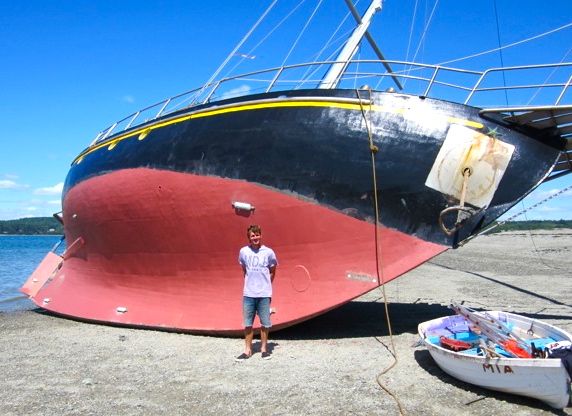 Rather than pay to have Prinses Mia hauled to apply anti-fouling paint, he careened her while visiting Maine. He motored in to shallow water and waited for the tide to fall. To ensure she laid on the correct side as the water fell, he pulled over with a line attached to the top of the mast. To pull her down on one side, he used a spinnaker halyard attached to a tree. For the other, he used his cousin’s car.
Rather than pay to have Prinses Mia hauled to apply anti-fouling paint, he careened her while visiting Maine. He motored in to shallow water and waited for the tide to fall. To ensure she laid on the correct side as the water fell, he pulled over with a line attached to the top of the mast. To pull her down on one side, he used a spinnaker halyard attached to a tree. For the other, he used his cousin’s car.(Martijn Dijkstra photo) Some of his innovations haven’t panned out. He says, “Once, I hooked a 50cc scooter motor to my anchor windlass. I attached it with belts. When I turned it on everything started shaking and jumping but the anchor came in real fast. For a time, I had the fastest anchor winch in the world. So nice if you’re in a hurry!”
In the end, though, he deemed the add-on “completely scary” and scrapped it. A slight bump, where he took a grinder to his creation, is still visible on Prinses Mia’s deck.
The stairs leading from the pilothouse to the main cabin. The stair treads were salvaged off a small Dutch cruise ship.Below decks, Prinses Mia resembles a cross between a naval vessel and a maritime museum. Her bones are stout – her living quarters connected by three water tight compartments, each accessed by a steel door. Her bronze portholes have fold down reinforcements for storm conditions. But everywhere below, Princes Mia’s interior features more of Martijn’s resourceful salvaging. It starts with the first steps you take from the pilothouse. On the heavy set of wood companionway steps, each tread is capped with intricate brass plates from a cruise ship in Holland.
And then there’s the living area that would seem to calm a person in even the roughest seas. A Persian rug covers the hardwood cabin sole. A bronze and fabric lamp hangs over the solid oak galley table. None of these items were bought. Martijn says he came across most of them in the course of his travels. He pulled them from dumpsters, gathered them up at construction sites. Martijn comments often that he is amazed at what people throw away.
The collection gives the vessel an air of Aladdin’s cave. She looks like she cost a fortune but Martijn hasn’t spent one on her.
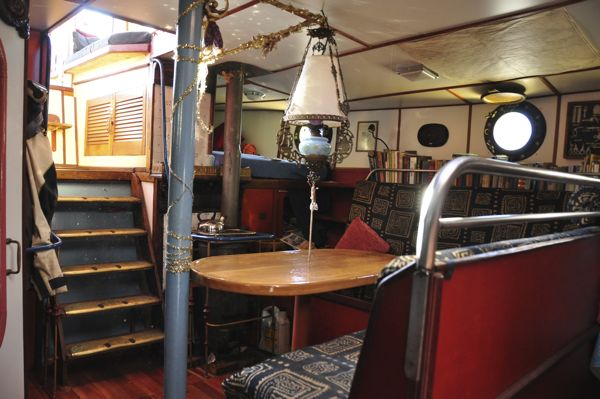 The main cabin.
The main cabin.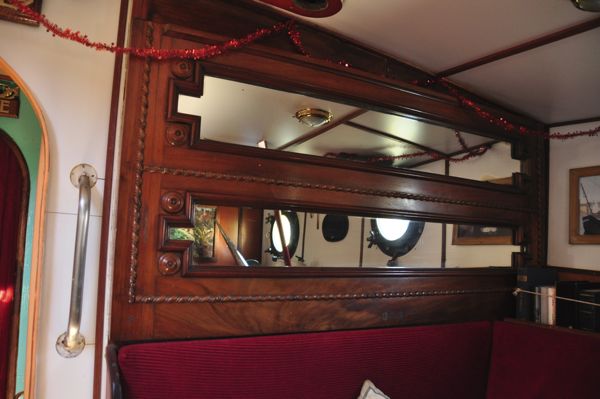 Carved mirrors above the settee have been re-purposed from pieces of furniture.
Carved mirrors above the settee have been re-purposed from pieces of furniture.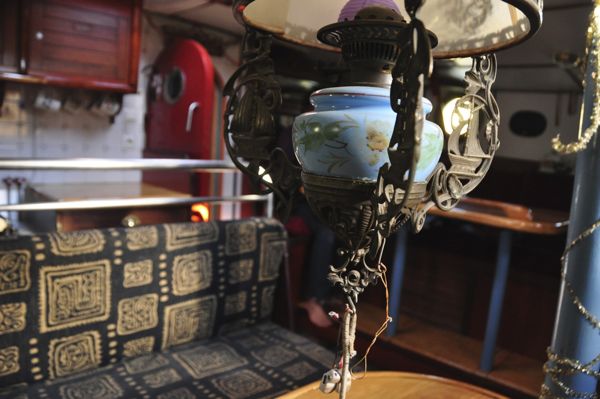 The lamp over the main cabin table. Visible behind, the tiled galley.
The lamp over the main cabin table. Visible behind, the tiled galley.[page]
Construction on Prinses Mia began in 1980. Her first owner rigged her much like the Norwegian life boats she was designed after – two wood masts and four-sided, gaff sails. She didn’t see much use. Then she was sold.
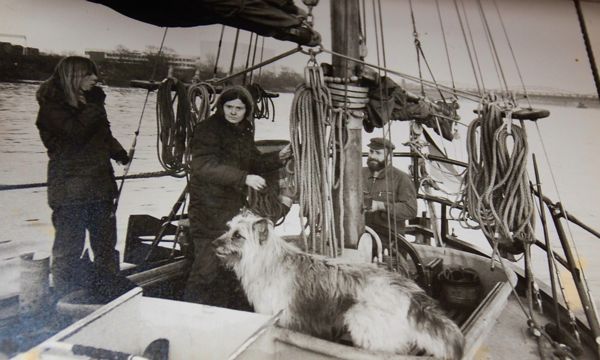 Prinses Mia – originally named “Sea Cloud of Lamarn” – as originally rigged. As a ketch, she had a mast in the cockpit. Later in the vessel’s life, the spar was removed.
Prinses Mia – originally named “Sea Cloud of Lamarn” – as originally rigged. As a ketch, she had a mast in the cockpit. Later in the vessel’s life, the spar was removed.(Martijn Dijkstra photo) The second owner decided to make major changes. This is where Princes Mia came in to Martijn’s life.
Prinses Mia’s new owner asked Martijn to help with the boat’s refit. Martijn designed a balanced rudder to replace the original transom hung on. He also suggested a new sail plan. The original ketch rig was replaced with a single, aluminum mast sourced from a Beneteau 50 whose owner wanted a taller rig.
As much work as was done to the boat, the second owner didn’t get much use out of it. “He sailed her maybe for an hour. And that was on a lake,” Martijn says. “He motored around a bit, too. But that was it.”
All the while Princes Mia was being worked on by that second owner, Martijn cruised aboard his sailboat Rotop, which he’d owned since he was 18. Starting about a half a decade ago, he stopped in at Oriental often, in the spring and the fall. A few years ago, he met his partner Ana. They had a daughter, Mia. Then, one day about three years ago, Martijn’s dad, who had been telling him he needed to buy a larger boat, called from Holland. He said, “I found your next boat.”
That boat was Princes Mia. Martijn bought her in 2011.
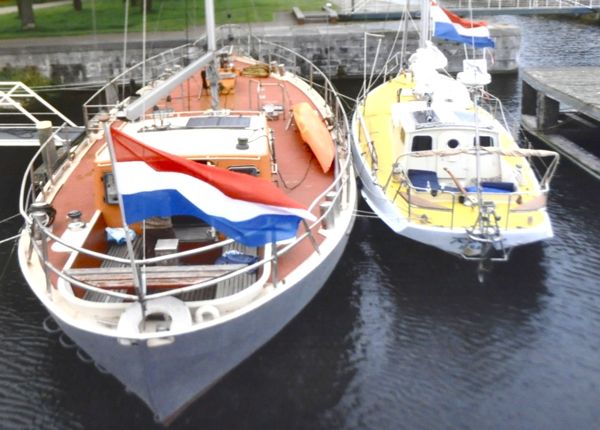 Prinses Mia and Rotop. Martijn put 70,000 miles under Rotop’s keel before selling her to continue cruising on his bigger boat. He says he cruised for years aboard Rotop on an average of $150 per month.
Prinses Mia and Rotop. Martijn put 70,000 miles under Rotop’s keel before selling her to continue cruising on his bigger boat. He says he cruised for years aboard Rotop on an average of $150 per month.Martijn spent the next year and a half in the Netherlands completing his new boat. Though the man he purchased her from had spent years working on her, he had never completed the interior. And so, Martijn set to work. Using mostly salvaged materials, Martijn installed new cabinetry, a wood stove and much-needed storage. The floorboards in the forward stateroom were once used to dry Dutch cheese. The stains are still visible. The wood-burning stove was built from a car’s fuel tank.
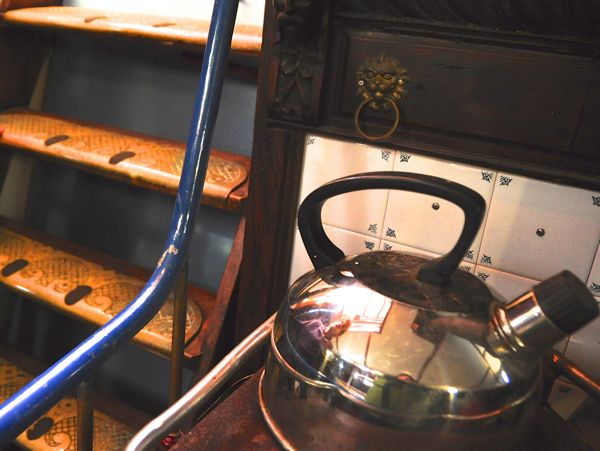 Martijn heats aboard with wood. The tiles behind the wood stove are fastened with screws in the traditional Dutch manner.
Martijn heats aboard with wood. The tiles behind the wood stove are fastened with screws in the traditional Dutch manner.Some of his varnish he used came from a dump in Bermuda. (Again, he wonders at what people toss away.) Other coatings, from bottom paint to two-part finishes, were sourced in like fashion. This explains the predominance of colors not often associated with yachting – the teal, the peach, and purple, tan, beige, and reds. “Most of my paint comes from the dump or the trash,” he says. “That’s why my color is so funny.”
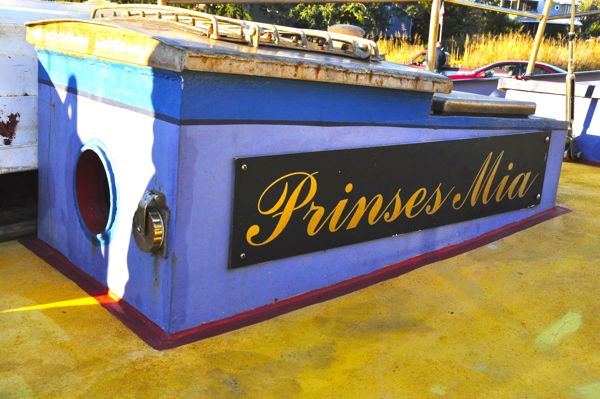 Prinses Mia is a boat of many paints. Her name has more than one source as well. Prinses was the name of a boat Martijn’s dad bought when Martijn was 12 years old. She was pretty but wound up being scrapped for the engine. Mia is the name of Martijn’s daughter.
Prinses Mia is a boat of many paints. Her name has more than one source as well. Prinses was the name of a boat Martijn’s dad bought when Martijn was 12 years old. She was pretty but wound up being scrapped for the engine. Mia is the name of Martijn’s daughter.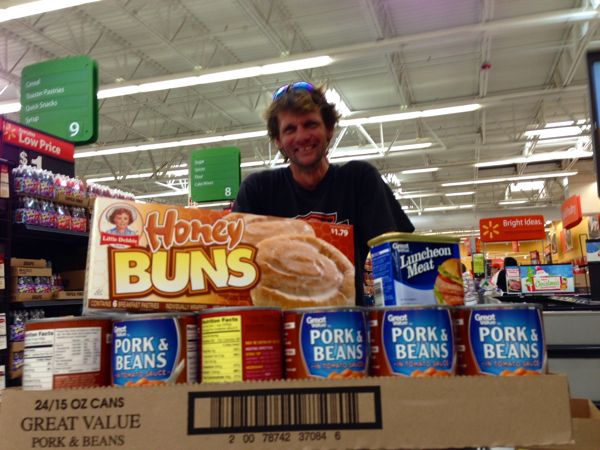 Martijn provisioned while in town. One advantage of a larger boat is being able to stock up on supplies where they’re cheapest. In addition to low prices, he took advantage of stocks he might not easily find in other countries – pork and beans and snack cakes. Though his diet is heavy on tinned goods and noodles, he says the Honey Buns are reserved for his daughter Mia.
Martijn provisioned while in town. One advantage of a larger boat is being able to stock up on supplies where they’re cheapest. In addition to low prices, he took advantage of stocks he might not easily find in other countries – pork and beans and snack cakes. Though his diet is heavy on tinned goods and noodles, he says the Honey Buns are reserved for his daughter Mia.In October 2012, Prinses Mia was ready. Martijn, Ana and Mia put to sea. Just over a year and 11,000 sea miles later, he made port in Oriental in early November. He arrived alone. Ana and Mia remained in Bermuda with Ana’s parents.
[page]
One major expense many sailors don’t take in to consideration is fuel. Thought sailboats have a seemingly free source of wind propulsion, sailors find themselves motoring more often than they expected to. This can dent all but the heartiest budget.
Martijn says sailors with the same engine as he does – a Perkins 4.236 – report spending a dollar on fuel for every mile motored.
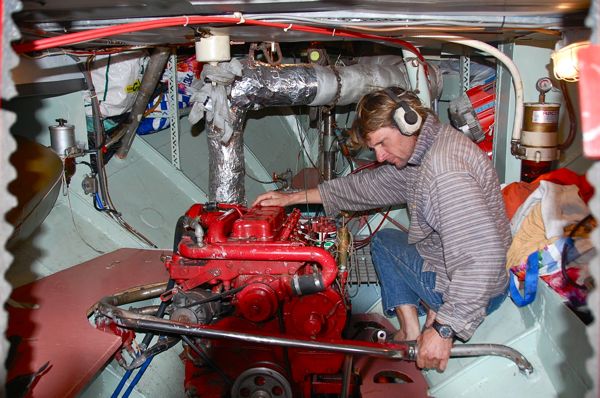 Martijn checks his engine while under way. Princes Mia has a dry exhaust as found on many commercial vessels. While this system is simple, it is loud – hence the ear muffs.
Martijn checks his engine while under way. Princes Mia has a dry exhaust as found on many commercial vessels. While this system is simple, it is loud – hence the ear muffs.While some can afford this, it’s not in Martin’s budget. Or mindset. “I’m cheap,” is how he explains it. “If I had a lot of money, I’d buy diesel.” Instead of using limited funds to buy fuel, he makes it.
For years, on Rotop and now on Prinses Mia, Martijn runs his engine on used fryer oil and discarded diesel.
When Martijn arrives in port, he collects used grease and old diesel. While in Oriental, he acquired 45 gallons of diesel from a nearby marina. Old cooking grease works, too. (Though in the past few years, Martijn has found the supply of the grease has fallen off as restaurants hold on to the cooking oil for biofuel companies to pick it up.)
Martijn brings the fuel back to Prinses Mia in jerry cans and once there, whether its diesel or cooking oil, he starts the one-man refining process. It involves some time commitment, t-shirt and sweatshirt fabric.
Few boats can boast of a palm tree in the head. Princes Mia can. Martijn brought the plant on board in Annapolis where someone had thrown it out. He says it’s happy on a diet of limited light and shower water.The first step is to strain the debris-filled, often sludgy, fluid. “A t-shirt works good”, he says. Next, he pours the fuel in to one of Princes Mia’s multiple fuel tanks. One of his goals is to store a year’s worth of fuel aboard – over 400 gallons
Before the fuel can be used in the engine, it needs further filtering.
One filter removes water – a common fuel contaminant. Other filters – a total of 4 – remove debris that might clog the engine’s injectors or cause it to run sluggishly.After all this cleaning, the fuel is ready to be burned.
Since leaving Holland last year, Martijn estimates he’s used his engine 300 hours. Only a few of those hours were on diesel he purchased.
As economical as this system has proven, it’s not perfect. Martijn’s Perkins engine isn’t fond of this fryer grease diet. “With the cooking oil, he’s not happy,” Martijn says. “We don’t get along.” Martijn’s made accommodations – adding a bit of diesel fuel to the cooking oil to ensure the engine runs properly.
During his stay in Oriental, one of his missions was sourcing a new motor. He is looking for a 70 to 80 horse power diesel engine – possibly a Nissan, Mitsubishi or Kubota. These engines are better suited for running on fryer grease. He would consider selling his Perkins, which runs fine, to pay for the new motor.
He’s already accomplished another mission that earned him a lot of thanks in Oriental.
[page]
Soon after arriving in Oriental in November, Martijn was told of an ongoing controversy in the town’s anchorage.
Pascal Ott and Monique Christmann aboard the sailboat “Primadonna” had occupied a spot in the anchorage for a year. This was taking up valuable space, especially at a time of year when many boats were traveling south. Word had spread in the cruising community that boats were bypassing Oriental because the red steel boat – and three other homesteading boats – were occupying much of the anchorage.
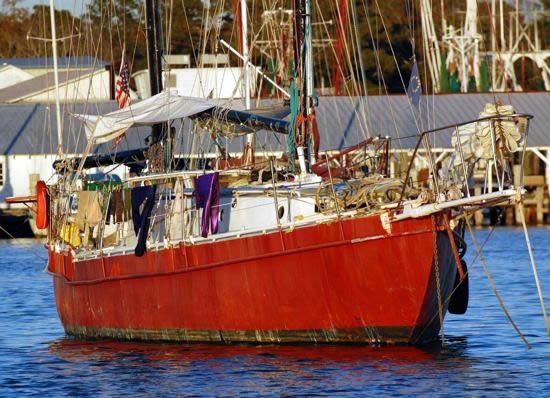 Primadonna
PrimadonnaAs reported in a Shipping News in July, Primadonna’s French crew claimed they couldn’t leave because they lacked funds, fuel and a few parts for their boat. Area citizens, churches and organizations had been pitching in since Primadonna arrived in November of 2012. Despite the help, they remained.
In May, Monique was arrested for shoplifting. In October, Pascal asked a local man to co-endorse a check for $2,980. Pascal received the cash. The check proved bad and Pascal only repaid $500. He kept the balance.
Many Oriental citizens were frustrated with Primadonna’s ongoing presence in the anchorage. Yet for all the controversy surrounding Primadonna, no one could seem to get the steel boat to leave. The US Coast Guard was called. ICE (US Immigrations and Customs Enforcement), and border control issues raised too. Numerous calls were made to the Homeland Security Hotline. Even the French Consulate was contacted but that too, brought no result. The Pamlico County Sheriff’s Department did no better. Oriental’s Town Board did nothing.
Martijn on the other hand, took action. He says that, given the hospitality he knew in Oriental, he found it “impossible to believe” that with after a year’s worth of assistance from area residents, Primadonna’s crew had been unable to fix the boat’s engine. So almost immediately upon arriving in town, he kayaked over and offered to help Pascal Ott.
Aboard Primadonna, the two men went to work. When efforts to repair the engine proved unsuccessful Martijn says Pascal, “did not even say thank you. Then he asked me to fix his outboard engine.” And then, Pascal had a final request. He asked Martijn to tow Primadonna to Morehead City.
And that is how Martijn Dykstra became something of a folk hero in Oriental. Minutes after 7a on November 12, Prinses Mia took Primadonna in tow and pulled her from Oriental’s anchorage. Around noon on that Tuesday, Primadonna was secured to a mooring in Morehead City. Martijn’s big steel boat had achieved in few hours what multiple agencies seemed helpless to do over much of the past year. That night at The Silos, many came up to him and thanked him. Several suggested he be the Grand Marshal in the Spirit of Christmas parade in mid-December.
After helping lift her anchors, Martijn tows Primadonna from the anchorage, in front of the Oriental bridge and ……past marker #8 at the end of Oriental’s breakwater. A few hours later…… the French vessel is towed down Adams Creek canal toward Morehead City, where the French sailboat’s captain asked she be towed.Martijn says Primadonna’s crew did not offer to pay for the fuel he used for the towing job to and from Morehead. Primadonna’s crew did not even thank him. He says that’s okay – he still likes helping people. As for the three boats that continued squatting in the anchorage, he says, “I wish we could tow the other ones.”
Next, a sail aboard Prinses Mia.
[page]
During his visit, Martijn and a few friends went for a sunset sail. The winds were light. It was a brisk afternoon with temperatures just above freezing – warm enough to use Prinses Mia’s wood stove. Moments after leaving the dock, he turned off his engine and proceeded out of Oriental’s harbor under sail.
Under canvas alone, Princes Mia ghosts past one of the long term anchorage residents. She proceeds out on to the Neuse River….…where Martijn hoists the mainsail. Soon she is sailing at 7 knots. As the sun sets, the western sky illuminates the steel vessel, lighting up….…the anchor windlass. With night falling, Princess Mia makes her way through the darkness with Martijn steering..…from inside the pilothouse.MartijnMartijn wants to spend a few more days in Oriental. He still hopes to find an engine with a taste for fryer oil. If he finds nothing and a favorable weather window presents itself, he plans to sail back to Bermuda.
Related Links:
